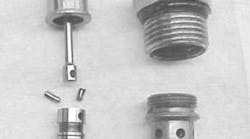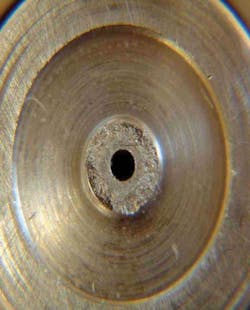It's difficult to predict dynamic forces and impact loads on a valve that shifts in less than 50 ms. When testing valves at Eaton Hydraulics, we cycle valves repeatedly to simulate years of use. Computer modeling and engineering expertise are valuable, but nothing proves a design quite like a pounding endurance test.
When developing a new range of directional valves, we performed endurance tests on production prototypes and another company's valve. At full flow and pressure, loading snapped the roll pin holding both valves together in less than 250,000 cycles, Figure 1. As a result, our engineers switched to a stronger, solid steel dowel pin.
Flow-induced Loads and Effects
Flow through a cartridge valve can produce unexpected consequences that reduce durability. Full flows can result in higher forces, erosion, cavitation, and even catastrophic failure. As Figure 2 shows, a 100-mesh filter screen failed from an alternating load caused by flow across the restrictive screen. Our engineers were able to specify a stronger screen after this failure, which would not have been revealed without an endurance qualification test.
Flow forces can have other damaging effects. To qualify our new EFV2 series proportional pressure-compensated flow-control valves, our engineers tested a prototype alongside another company's valve. After fewer than 200,000 cycles, the retaining ring holding the spool in both valves popped out of its groove, Figure 3. This failure, which resulted from high flow forces, could have lead to the loss of priority flow to critical functions. Rigorous endurance testing helped us improve the product before it was introduced.
Contact Loading and Wear
Because most valves have moving parts, we cycle components to ensure they will exhibit acceptable wear. Adhering to established standards are not enough when evaluating new materials or designs, We validate new designs through endurance testing. When we designed our new ERV3-10 proportional relief valves, endurance testing revealed a poor material and heat-treat selection for the relief valve seat, Figure 4. Detection of this failure resulted in an improved design, which would not have happened with only fatigue or burst testing. Endurance testing made the difference.
There are so many variations of screw-n cartridge valves, and no industry standard exists for endurance testing of them, so some manufacturers no longer conduct them. We perform endurance tests using test stands capable of 10,000 psi and 80 gpm (300 l/min) to ensure that all screw-in cartridge valves are fully endurance qualified.
Because of the diversity of cartridge valve functions, the test setup for endurance testing a valve can be difficult to define. The best way to design an endurance test is to perform a failure modes-and-effects analysis with field input to determine how the valve is likely to be used.
Nathan French, P. E., is supervising engineer, Screw-in Cartridge Valves, Eaton Hydraulics, Eden Prairie, Minn. Click here to visit the Eaton cartridge valves web page.





